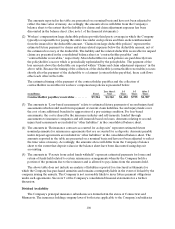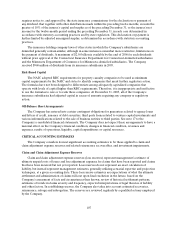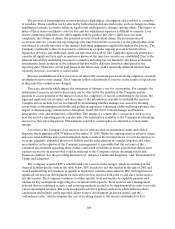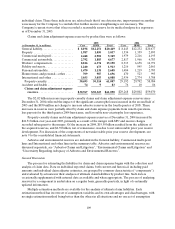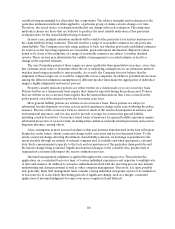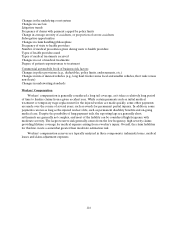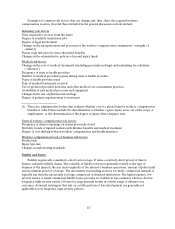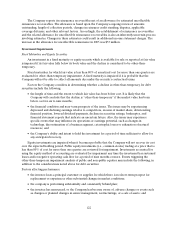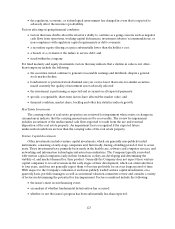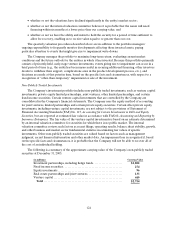Travelers 2005 Annual Report Download - page 127
Download and view the complete annual report
Please find page 127 of the 2005 Travelers annual report below. You can navigate through the pages in the report by either clicking on the pages listed below, or by using the keyword search tool below to find specific information within the annual report.
115
Property reserves are typically analyzed in two components, one for catastrophic or other large single
events, and another for all other events. Examples of common risk factors that can change and, thus, affect
the required property reserves (beyond those included in the general discussion section)include:
Property risk factors
Physical concentration of policyholders
Availability and cost of local contractors
For the more severe catastrophic events, “demand surge” inflation,whereby the greatly increased demand
for building materials such as plywood far surpasses the immediate supply, leading to short-term material
increases in building material costs
Local building codes
Amount of time to return property to full usage (for business interruption claims)
Court interpretation of policy provisions (such as occurrence definition)
Lags in reporting claims (e.g., winter damage to summer homes, hidden damage after an earthquake)
Court or legislative changes to the statute of limitations
Property book of business risk factors
Policy provisions mix (e.g., deductibles, policy limits, endorsements)
Changes in underwriting standards
Commercial Multi-Peril
Commercial multi-peril provides a combination of property and liability coverage typically for small
businesses and, therefore, includes both short and longtail coverages. For property coverage, it generally
takes a relatively short period of time to close claims, while for the other coverages, generally for the
liability coverages, it takes a longer period of time to close claims.
The reserving risk for this line is dominated by the liability coverage portion of this product, except
occasionally in the event of catastrophic or large single losses. The reserving risk for this line differs from
that of the general liability product line and the property product line due to the nature of the customer.
Commercial multi-peril is generally sold to smaller sized accounts, while the customer profile for general
liability and property include larger customers.
See the discussions under the property and general liability product lines with regard to reserving risk
for commercial multi-peril.
Commercial Automobile
The commercial automobile product line is a mix of property and liability coverages and, therefore,
includes both short and long tail coverages. The payments that are made quickly typically pertain to auto
physical damage (property) claims and property damage (liability) claims. The payments that take longer
to finalize and are more difficult to estimate relate to bodily injury claims. In general, claim reporting lags
are minor, claim complexity is not a major issue, and the line is viewed as high frequency, low to moderate
severity. Overall, the claim liabilities for this line create a moderate estimation risk.
Commercial automobile reserves are typically analyzed in four components; bodily injury liability,
property damage liability, collision claims and comprehensive claims. These last two components have
minimum reserve risk and fast payouts and, accordingly, separate risk factors are not presented.
Examples of common risk factors that can change and, thus, affect the required commercial
automobile reserves (beyond those included in the general discussion section)include:
Bodily injury and property damage liability risk factors
Trends in jury awards



